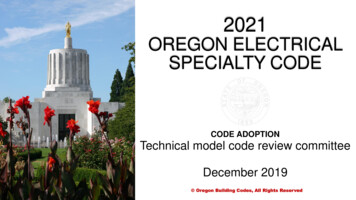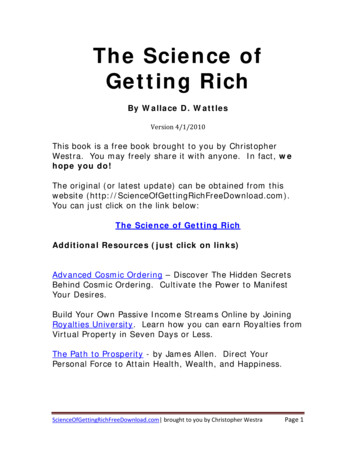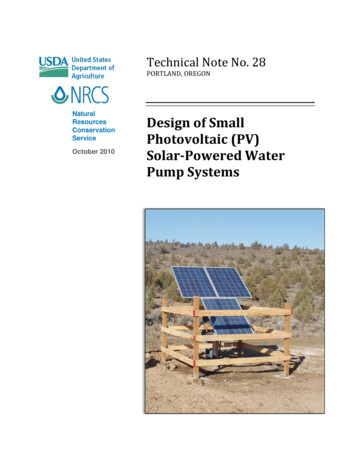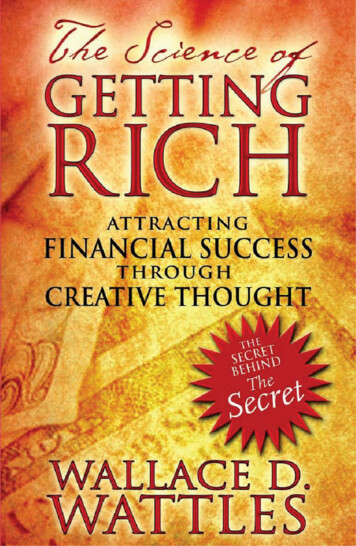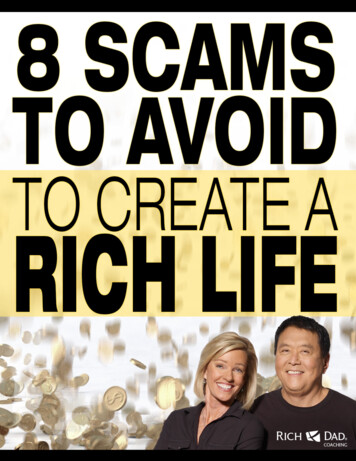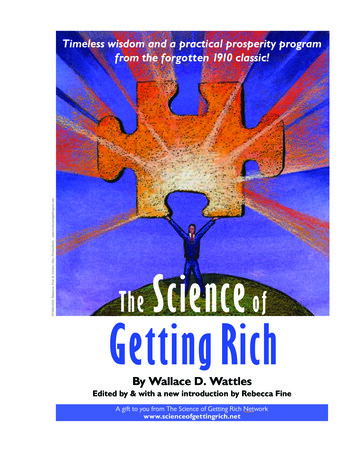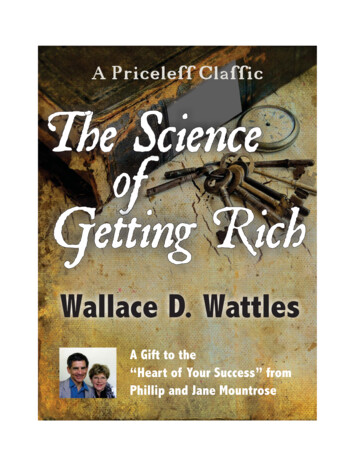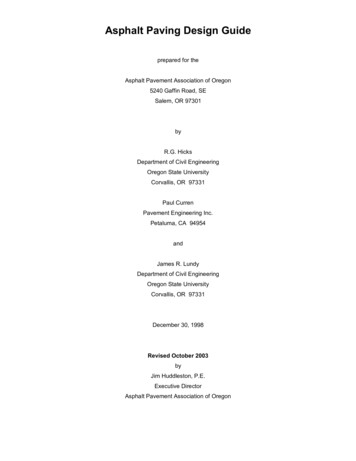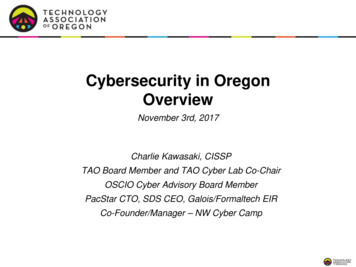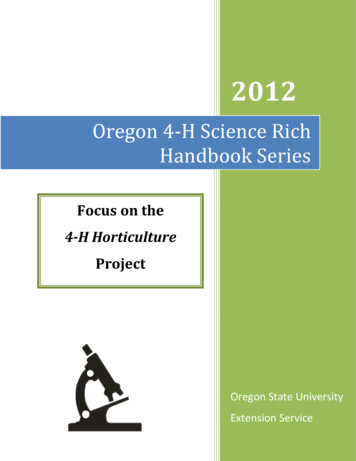
Transcription
2012Oregon 4-H Science RichHandbook SeriesFocus on the4-H HorticultureProjectOregon State UniversityExtension Service
Welcome to 4-H ScienceThis handbook series was developed to help Oregon 4-H youth developmentprofessionals and volunteers become familiar with the national 4-H science framework and howto think intentionally about 4-H Science programming. It will help improve the understandingand delivery of science within appropriate 4-H projects.4-H, with its direct connection to the Cooperative Extension System’s cutting edgeresearch and the resources of the nation’s 106 land-grant universities and colleges, providesyouth with hands-on learning experiences that foster exploration, discovery, and passion for thesciences. Science is one of the three national Mission Mandates for 4-H. 4-H Science programssupport youth to develop science, technology, engineering and applied math (STEM) skills.This handbook will1. Define 4-H Science2. Introduce tools to focus on 4-H Science in this project areaa. 4-H Science Checklistb. 4-H Science Eight Essential Elementsc. 4-H Science Inquiry in Action Flowchartd. 4-H Science Logic Model3. Provide An Example of a Science Rich 4-H Inquiry ActivityAdapted and written by Virginia Bourdeau, 4-H Youth Development Professor, Oregon State University ExtensionService. 2012 Oregon State University 4-H Youth DevelopmentOregon State University Extension Service offers educational programs, activities, and materials– withoutdiscrimination based on race, color, religion, sex, sexual orientation, national origin, age, marital status, disability,or disabled veteran or Vietnam-era veteran status. Oregon State University Extension Service is an EqualOpportunity Employer.2
Why 4-H Science?The National Academy of Science’s 2007 Rising Above the Gathering Storm report statedthat, “the United States presently faces a significant challenge - young people are not preparedwith the necessary Science, Engineering and Technology workforce skills to compete in the 21stcentury.” In their 2011 review of America’s position five years later, entitled Rising Above theGathering Storm, Revisited: Rapidly Approaching Category 5, the Academy committee’sunanimous view is that our nation’s outlook has worsened.The 2009 National Assessment of Educational Program report indicates Oregon 8 th gradestudents are proficient in math (37%) and science (35%) slightly above the national average.However, just 15% of Hispanics and 12% of Black 8th grade students are proficient in mathcompared to 41% of White students. For science, just 12% of Hispanics and 13% of Black 8 thgraders are proficient compared to 40% of White students. The percentage of Oregon 8th gradestudents who reported they “never or hardly ever” design a science experiment was 35%,compared to 39% nationally. The percent of Oregon 8th grade students who report that they“never or hardly ever” write reports on science projects was 43%, compared to 47% nationally.The national 4-H Science Mission Mandate targets addressing these needs at the locallevel through the broad range of 4-H projects which are based on science. 4-H Science programsreach more than 5.9 million youth in urban, suburban and rural communities across the country.4-H Science programs support youth to develop science, technology, engineering and appliedmath (STEM) skills. Oregon 4-H youth development professionals and volunteers can helpaddress this need using the resources and tools in this handbook.3
1. The 4-H Science ChecklistThe 4-H Science Checklist is provided in Appendix A. The checklist includes sevenitems that have been identified as the most critical program components to include in a 4-HScience Program. You may be thinking, “I don’t lead a 4-H Science Club! I’m just aHorticulture club leader.” The goal of the checklist is to help 4-H youth developmentprofessionals and volunteers identify and reinforce the science learning opportunities across avariety of 4-H projects.A paragraph at the top of the check list explains, “A ‘Science Ready’ 4-H experience is aprogram that is framed in science concepts, based on science standards and intentionally targetsthe development of science abilities and the outcomes articulated by the 4-H Science LogicModel. Additionally, it integrates the Essential Elements and engages participants in experientialand inquiry based learning.”Let’s look at what is included in the program components of a “Science Ready” 4-H experience. National Science Education StandardsThese standards are used by Oregon’s Department of Education to develop the sciencebenchmarks for K-12 education. The national standards provide a common andconsistent base of quality content on which 4-H program design, development, deliveryand assessment is built. 4-H Science AbilitiesThis section includes a list of 30 science abilities or practices that are skills used inscience, engineering and technology. These abilities can be used across 4-H projectareas to help youth unleash their natural curiosity about the world. Youth will use theseskills and understand what it means to think and act like a scientist. Youth Development- Essential ElementsOregon 4-H youth development professionals and volunteers are already addressing theseopportunities in their work with youth. The four needs of youth to experience mastery,independence, belonging and generosity are supported by the Eight Essential Elements ofPositive Youth Development. Specific examples of how 4-H youth developmentprofessionals and volunteers can implement these are provided in the 4-H Science: EightEssential Elements (Section 2) in this handbook. Trained, Caring Adults and VolunteersOregon 4-H youth development professionals and volunteers are provided a variety ofopportunities, including this handbook, to increase their skills as front-line youthworkers. This handbook will help you to incorporate the 4-H Science Checklist, 4-HScience Logic Model, 4-H Science Inquiry in Action Flow Chart, and 4-H Science CoreCompetencies into your programming.4
An Experiential ApproachOregon 4-H youth development professionals and volunteers are familiar with the 4-Hexperiential learning model. All 4-H project materials rely on this approach to create andreinforce learning.4-H Experiential Model1. EXPERIENCE theactivity; perform, doit5. APPLY what waslearned to a similaror differentsituationsAPPLY4. GENERALIZE to connectthe experience to realworld examples2. SHARE theresults, reactions,observationspubliclyDOREFLECT3. PROCESS bydiscussing, looking atthe experience, analyze,reflect Inquiry to Foster Creativity and Curiosity“Inquiry is a process that all individuals naturally use in approaching new situations andsolving problems in life. By engaging in inquiry, children gain experience that willimprove their capacity to handle life situations and solve everyday problems.” (EdmundMarek and Ann Cavallo, 1997). Inquiry can happen in a variety of ways across 4-Hprograms. Ideas on encouraging inquiry and use of the Inquiry in Action Flow Chart(Appendix C) will be presented in Section 3 of this handbook. 4-H Science Logic ModelThe 4-H Science Logic Model articulates the opportunity to achieve science outcomesacross 4-H education programs. It is provided in Appendix D. Outcomes happen at threelevels. Short-term outcomes are those that happen immediately after an educationexperience such as knowledge gains. Intermediate or long-term outcomes happen afterthe learner has a chance to integrate their new knowledge into different actions.5
2. 4-H Science Core Competencies: Eight Essential ElementsOne framework for understanding youth development in 4-H is the eight essentialelements. This framework provided the structure for development of the 4-H Science CoreCompetencies. The 4-H Science Core Competencies identify specific actions or behaviors of 4H youth development workers and volunteers that create a positive atmosphere or context forlearning. The four needs of youth to experience mastery, independence, belonging andgenerosity are supported by the Eight Essential Elements of Positive Youth Development.These are item 3 on the 4-H Science Checklist. A 4-H Science Competency Self-Assessment isprovided in Appendix B.Caring Adult (Belonging)4-H youth development professionals and volunteers understand that each young person benefitsfrom a positive relationship with a caring adult by:1. Communicating the capacity of all youth to learn and experience success.2. Being willing to learn alongside youth.3. Being comfortable not having all the answers.4. Demonstrating support for all youth.5. Understanding and caring about youth and their families.6. Appreciating the context in which youth and families live.Safe Environment (Belonging)4-H youth development professionals and volunteers create an emotionally and physically safelearning environment by:1. Modeling strategies for conflict resolution.2. Encouraging youth to share new ideas and different perspectives.3. Modeling and facilitating how to give and receive constructive criticism.Inclusive Environment (Belonging)4-H youth development professionals and volunteers design inclusive learning environments by:1. Promoting teamwork and cooperation.2. Providing opportunities for youth to teach and learn from each other.3. Demonstrating respect for others.4. Fostering an environment of mutual respect for others.See Oneself in the Future (Independence)4-H youth development professionals and volunteers nurture an atmosphere of optimism and apositive belief in the future by:1. Encouraging the belief that all youth can learn science or pursue science careers.2. Creating a science-friendly learning environment.3. Promoting science careers for all youth, regardless of their gender, race, or ethnicity.4. Demonstrating how science can improve the world.6
Values and Practices Service to Others (Generosity/ Mastery)4-H youth development professionals and volunteers encourage an ethic of caring and civicresponsibility by:1. Helping youth connect to the community through service projects.2. Encouraging empathy for others.3. Engaging youth in real world science activities that consider the needs of others.4. Understanding the positive and negative effects that science has on humans.Opportunities for Self-Determination (Independence)4-H youth development professionals and volunteers encourage and support independence inyouth by:1. Designing experiential, inquiry-based opportunities for youth to learn 4-H Science skills.2. Challenging youth to explore new or different 4-H Science projects and areas of learning.3. Supporting youth in achieving their goals in the face of setbacks.4. Knowing how to foster an increasing development of skills in youth.Opportunities for Mastery4-H youth development professionals and volunteers provide opportunities for youth to developskills, competence, and expertise by:1. Designing experiential, inquiry-based opportunities for youth to learn 4-H Science skills.2. Challenging youth to explore new or different 4-H Science projects and areas of learning.3. Supporting youth in achieving their goals in the face of setbacks.4. Knowing how to foster an increasing development of skills in youth.Engagement in Learning (Mastery)4-H youth development professionals and volunteers encourage youth to direct and manage theirown learning by:1. Assisting youth in setting realistic goals of their own choice.2. Encouraging an inquiry approach to learning and exploration.3. Providing sufficient time and an appropriate environment for thorough learning.7
3. 4-H Science Inquiry in ActionThe National Science Education Standards (1996) employ Science as Inquiry as a skillacross all science content areas. Like life skills in traditional 4-H projects, the process of usinginquiry supports content learning. Oregon’s 4-H Science Inquiry in Action Flowchart (AppendixC) shows the relationship between the 4-H Experiential Learning Model and the steps applied inscience inquiry.On the Inquiry in Action flowchart, note that the first two steps in the process are led bythe coach or leader. These are, “1. Determine what learners know or have observed. Identifyknowledge gaps or misunderstandings.” and, “2. What do learners want to know? Whatquestions do learners have?” These two steps are where the leader introduces the topic andengages the learners in using their inquiry process skills.Learning to lead learner-centered, inquiry based activities can be a challenge for 4-Hyouth development professionals and volunteers who are more familiar with prescribed projectactivities which follow cookbook-like steps to a known outcome. With repeated application ofthe inquiry model – learning by doing – leaders and learners become familiar with the stepsapplied in science inquiry. Learners will soon take initiative and become engaged in designingtheir own learning experiences.Steps 3 through 10 of the flowchart are intended to be primarily learner driven. For easeof management, youth can be put into teams to work on an inquiry activity. There are a varietyof ways the leader can proceed with facilitating inquiry. In Guided Inquiry, learners areprovided with a problem to investigate and the materials necessary to carry out the investigation.The learners devise their own procedure to solve the problem. The state 4-H project page forScience, Engineering and Technology ingand-technology) has a link to ten videos that show examples of how to lead guided inquiryactivities in a selection of 4-H projects.A second way of facilitating is called Open Inquiry. The learners formulate their ownproblem to investigate and devise strategies to carry out their investigation (Steps 4-6). This caninclude determining which equipment to use to collect information from a selection provided andcreating their own data chart to record information.Science education can be improved by immersing learners in the process of usingscientific knowledge to “do” science. Informal learning environments are ideal settings forlearners to practice skills necessary for scientific inquiry. Experiential learning may be definedas learning based on personal experiences or direct observation. Experience and observation arekey to the scientific inquiry process. An example of a project activity using inquiry will bepresented next in this handbook.8
4. An Example of a Science Rich 4-H Horticulture Inquiry ActivityIn this section, a lesson in the Horticulture project book Level A: See Them Sprout calledWhile you Wait, Seeds Up Close, Part 2, Geminating Seeds, page 17, will be adapted to beScience Rich. This is how the lesson is presented in the project book:YOU NEED several paper towels small plastic bag long sheet of paper pencil magnifying glass, optional 10 lima or kidney bean seeds soaked overnight1. Plant a question about the seed that has to do with sprouting:2. Sprout a guess. I predict:3. Get Growing:Dampen a paper towel. Fold it once and place all the seeds on it. Fold it again andplace it in a plastic bag for a week. Keep it in a warm place. Write down the date.Moist seeds should sprout in 7 to 10 days.4. Record what you see:Make a folding “book” so it’s easy to write down what you see. Fold a long strip ofpaper so it looks like an accordion. Look at the seeds every day. Every time youobserve a change in your seeds, draw on one section of your folding book.5. Harvest your findings;After a week or so, unfold your, “book” and look at the pictures. What Happened?You probably have a storyboard about “How a Seed Sprouts.”Employing the 4-H Science ChecklistRemember, the 4-H Science Checklist (Appendix A) includes seven items that have beenidentified as the most critical components to include in a 4-H Science Program, so this is a goodplace to start when planning to teach a lesson.Let’s begin with the Science Abilities list. What abilities will youth practice in thislesson as written? (Predict, Observe) This lesson is a Guided Inquiry activity. Much of theexperimental design is prescribed. Youth are told the type of seeds to use, the treatment of theseeds such as moisture and temperature, and the expected length of time to sprouting.9
Is there an opportunity to include more science abilities? YES! Using the list of ScienceAbilities and the Inquiry in Action Flowchart an Open Inquiry experience that is more ScienceRich can be created.Reinventing the ActivityBeginning at step 1 on the Inquiry in Action flowchart, the coach will lead a discussionwith youth about what they know about seed germination. Are all seeds alike? Instead ofrestricting youth to lima or kidney bean seeds, why not provide learners with a variety of seeds?Corn is in the grass family; it has only one cotyledon. The beans have two cotyledons.In part 1 of this activity in the Horticulture book, youth learned that cotyledons provide food forgrowth until the plant can make food with its own leaves. This could lead youth to ask, “Is itbetter to have two cotyledons, like beans, than to have one cotyledon, like corn? Under whatconditions would it be better to have two cotyledons?” Now a whole range of possible questionsand experiments have been opened up to them!At step 3 of the Inquiry in Action flowchart, youth are to ask a question that can beanswered through a scientific investigation. To assist youth to ask a question, have them identifyall the things they might investigate about germinating seeds. What other variables could therebe in the seed experiment? The substrate could be changed. Is sand better than a paper towel forgermination? Seeds could be subjected to different temperatures, different amounts of water, orplaced in different types of containers. How is the speed of germination or the health of theyoung plant changed by different variables? Provide a variety of materials such as: Corn, bean and other seed types Paper towels Containers of water Petri dishes Peat pots, paper cups, recycled single serving yogurt cups Water proof trays or similar to place under the plant experiments Soil, sand, small gravel Fertilizer Small fan to simulate wind if available Thermometers Measuring instruments for the above liquid and dry materials Scales Hand lensBefore learners design experiments in Step 4, lead a discussion to check for understanding ofexperimental design. In and experiment, the dependent variable is the event studied and theexpected to change when the independent variable is changed. The controlled variables are thethings that are not changed.10
A team of youth might state their hypothesis about seeds this way, “If we place bean seeds ontwo paper towels and add water to one paper towel, then the bean seeds on the moist paper towelwill sprout.” Independent variables answer the question, “What do we change?”o One set up of beans has water on the towel, one does not. Water is theindependent variable. Dependent variables answer the question, “What do we observe?”o Youth will observe the beans which will or will not sprout. Controlled variables answer the question, “What so we keep the same?”o The type of paper towel, type of bean, and temperature of the room should be thesame for both the trials.Once you have reviewed the experimental design process, learners can move throughsteps 4 through 11 of the Inquiry in Action flow chart. Science Abilities they have anopportunity to use include Question, Infer, State a Problem, Predict, Plan an Investigation,Cooperate, Test, Measure, Use Tools, Observe, Organize, Summarize/Relate,Interpret/Analyze/Reason, Communicate, and Redesign.At step 10 on the flow chart the question is, “Are all Teams/Learners satisfied with theproposed analysis of findings?” If the answer is, “yes” they can move on to the next inquiry. Ifthe answer is, “No,” the flowchart takes them up to step12. At step 12 “Team re-designsquestion or asks a new question which can be explored through scientific investigation.” This isthe cyclical nature of science. In formal education youth rarely have the chance to re-design aproject. Allowing learning by trial and error supports the experiential model and gives youthcontrol of their experience.Remember that item three on the 4-H Science Checklist is the Essential Elements. In thisactivity 4-H youth development professionals and volunteers can create a positive learningenvironment by being willing to learn alongside youth and by being comfortable with not havingall the answers.An important skill for youth to practice as they learn to think and act like a scientist, ishow to communicate ideas and discoveries. Youth have the opportunity to practice many of thescience abilities on the 4-H Science Checklist by creating a Science Investigation Display for a4-H fair event. A description of the fair class, the display requirements and the judging criteriaare provided in the Science section of the State 4-H Fair book.11
ReferenceJamison, K. & Walahoski, J., 2010. 4-H Science 101: Development, Delivery and Assessment of4-H Science Programs. National 4-H Council.National Research Council (NRC). 2011. A framework for K-12 science education: Practices,crosscutting concepts, and core ideas. Washington, DC: National Academies Press.12
Appendix A4-H Science ChecklistA “Science Ready” 4-H experience is a program that is framed in Science concepts, based onScience standards and intentionally targets the development of science abilities and the outcomearticulated by the 4-H Science Logic Model. Additionally, it integrates the Essential Elementsand engages participants in experiential and inquiry based learning. In addition to the followingcriteria below, it’s also recommended that science programs offer a sustained learningexperience which offers youth the opportunity to be engaged in programs with relevantfrequency and duration. Utilize the following checklist to self-assess the program you deliver.To meet the needs of children, youth and theNation with high-quality science, engineering and technology programs Are you providing science, engineering and technology programs basedon National Science Education Standards - Science education standards arecriteria to judge quality: the quality of what young people know and are able to do; thequality of the science programs that provide the opportunity for children and youth tolearn science; the quality of science teaching; the quality of the system that supportsscience leaders and programs; and the quality of assessment practices and /Are you providing children and youth opportunities to improve theirScience Abilities?Predict, Hypothesize, Evaluate, State a Problem, Research Problem, Test, ProblemSolve Design Solutions, Measure, Collect Data, Draw/Design, Build/Construct, UseTools, Observe, Communicate, Organize, Infer, Question, Plan Investigation,Summarize/Relate, Invent/Implement Solutions, , Model/Graph/Use Numbers, Troubleshoot, Redesign,Optimize, Collaborate, Compare13
Are you providing opportunities for youth to experience and improve inthe Essential Elements of Positive Youth Development?Do youth get a chance at mastery – addressing and overcoming life challenges in yourprograms?Do youth cultivate independence and have an opportunity to see oneself as an activeparticipant in the future?Do youth develop a sense of belonging within a positive group?Do youth learn to share a spirit of generosity toward others?Are learning experiences led by trained, caring adult staff and volunteersacting as mentors, coaches, facilitators and co-learners who operatefrom a perspective that youth are partners and resources in their owndevelopment?Are activities led with an experiential approach to learning?Are activities using inquiry to foster the natural creativity and curiosityof youth?Does your program target one or more of the outcomes on the 4-HScience Logic Model and have you considered the frequency andduration necessary for youth to accomplish those outcomes?14
Appendix B- 4-H Science Competency Self-AssessmentPlease fill in the circle that tells you how much you are capable of using the knowledge and skills in each of theseareas when you work with youth in 4-H Science programs.0Never1Sometimes2Usually3Most ofthe �CARING ADULTI use language of respectI listen to youth in a nonjudgmental wayI demonstrate shared leadership through youth-adultpartnershipsI encourage youth to think about what they are learningI make verbal contact with all youthI encourage learners when they experience setbacksI offer praise and encouragement when youth take initiative andleadershipI identify, build on, and celebrate the potential of all youthI respect youth of different talents, abilities, sexual orientations,and faithsINCLUSIVE ENVIRONMENT (BELONGING)I help youth feel welcome and part of a groupI establish a climate of fairness and opennessI respond positively to the ranges of youths' feelingsI cultivate a sense of togetherness among youthI value and act upon the ideas of othersI serve as a role model for inclusion and toleranceI initiate, sustain, and nurture group interactions andrelationshipsSAFE ENVIRONMENTI conduct myself in a calm mannerI reduce or eliminate physical and environmental hazardsI re-emphasize ground rules related to conductI intervene when safety demands itSEE ONESELF IN THE FUTUREI project an optimistic, positive mannerI reinforce the idea that all youth can succeedI offer positive encouragement and support even in the face ofsetbacksI talk about the future and youth's role in it4-H Science Competency Self-Assessment 2009 National 4-H Council
VALUES AND PRACTICES SERVICE TO OTHERSI encourage youth to contribute to the communities in which theyliveI voice support for giving back to the community through serviceI believe in science's role in improving communitiesI provide opportunities for youth to link their experiences tocitizenshipI identify opportunities for youth to become civically engaged0Never1Sometimes2Usually3Most ofthe �ΟOPPORTUNITIES FOR SELF-DETERMINATIONI provide experiences that encourage youth to share evidenceI identify opportunities for youth to compare claims with eachotherI articulate strategies for data collection and analysisI work with youth to identify sources of informationI actively consult, involve, and encourage youth to contribute toothersI provide opportunities for youth to determine programexpectations and directionENGAGEMENT IN LEARNINGI guide youth in learning for themselvesI create opportunities for problem solving via discussion, debate,and negotiationI work with youth to establish appropriate goals for their ageI provide opportunities for youth to link their experiences to thereal worldI use a variety of questioning and motivational approachesI use multiple learning approaches to meet learners' needsOPPORTUNITIES FOR MASTERYI suggest challenges that can be explored by direct investigationΟI encourage youth to make predictionsΟI assist youth in developing hypotheses related to theirΟinvestigationsI allow youth to conduct formal and open-ended tests andΟexperimentsI have youth discuss their finding with each other and evaluateΟevidence criticallyI encourage youth to share their knowledge by teaching othersΟand leading new activitiesI help youth see setbacks as opportunities for new explorationsΟI support youth to set new goals, and try new ideas andΟapproachesI provide opportunity for youth to use appropriate technologyΟ4-H Science Competency Self-Assessment 2009 National 4-H Council16
Appendix C- Inquiry in Action Flowchart17
4-H Science Inquiry ModelCoach Lead/ProcessedActivities1. Determine what learners know or have observed.Identify knowledge gaps or misunderstandings.2. What do learners want to know? What questions dolearners have?LearnerTeamDrivenActivities3. Team asks a question whichcan be explored throughscientific investigation.12. Team re-designs question orasks a new question which can beexplored through scientificinvestigation.4. Team designs a simple scientificinvestigation.5. Team selects appropriate equipment tocollect data, designs a data sheet (if needed).Do6. Team collects data and completes data sheet.7. Team describes their investigation and their results.Share8. Team thinks critically and logically to make the relationshipbetween evidence and explanations and presents their analysis ofthe findings.Reflect9. Through group discussion apply findings to everydayexperiences or real-world examples.Apply10. Are all Teams/Learners satisfied with the proposed analysis offindings?11A. Yes: Move on to thenext inquiry.11B. No.18
Appendix D- 4-H Science Logic Model19
4-H Science Logic ModelSituationDescription of challenge,problem, or opportunity: InputsWhat we invest: ActivitiesWhat we do: OutputsWhat we produce:- Select and develop4-H Science curricula- Unsolved worldwidesocial problems need tobe addressed by science.- Federal, state andprivate funds.- 4-H Science curricula- Select and trainvolunteers- 4-H Infrastructure- In the US, shortage ofscientists & peopleunderstanding science.- Under-representationof women and minoritiesin science careers.- Need a diverse pool oftrained scientists toframe and solveproblems & educateothers.- General population inthe US (& worldwide)lacks basicunderstanding of sciencemethods and content("science literacy")- Land Grant UniversitySupport- County Extensionadministrators andagents, programcoordinators, andspecialists- TrainingMarket 4-H Science toincrease participationConduct non-formaleducation (learning andteaching, facilitatedinquiry and discovery)- Facilitate questionformation
century.” In their 2011 review of America’s position five years later, entitled Rising Above the Gathering Storm, Revisited: Rapidly Approaching Category 5, the Academy committee’s unanimous view is that our nation’s outlook has worsened. The 2009 National Assessment
